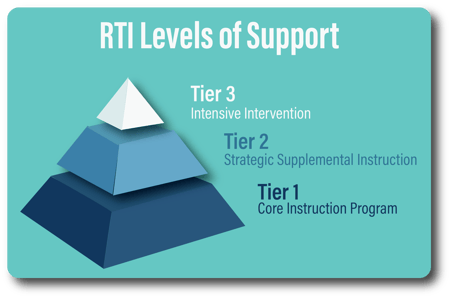STEMscopes Staff | Published April 27, 2023
Let’s explore the key features of Response to Intervention (RTI), a proactive multi-tiered approach to providing academic and behavioral support and intervention for identifying and addressing student needs before they escalate to more serious concerns.

 RTI is a framework to provide early intervention and support to students struggling academically or behaviorally.
RTI is a framework to provide early intervention and support to students struggling academically or behaviorally.
It is a process that involves multiple tiers of support based on data and evidence-based practices.
In an RTI model, teachers use data to identify students who may be struggling and provide targeted interventions to support their progress.
The RTI process involves screening, progress monitoring, and intervention.
 The three tiers of RTI break down as follows.
The three tiers of RTI break down as follows.
Tier 1 is the primary level of support and involves evidence-based instruction provided to all students in the classroom.
Tier 2 involves targeted interventions provided to students who fail to make the necessary progress in the classroom.
Tier 3 involves intensive interventions provided to students who continue to struggle even after receiving Tier 2 support.
The critical feature of RTI is the use of data to inform decision-making. Teachers collect data through universal screenings to identify students who are at risk of falling behind.
If students are identified as at-risk, they receive targeted interventions and progress monitoring to ensure they are making progress.
Students who do not respond to Tier 2 interventions may be referred for Tier 3 interventions.
There are several benefits of using an RTI model in schools.
Firstly, RTI provides early intervention and support to students struggling academically or behaviorally. By delivering targeted interventions early, students can receive the support they need to succeed in the classroom.
Secondly, RTI is based on data and evidence-based practices, which helps ensure that interventions are effective and resources are used efficiently.
Thirdly, RTI can help reduce the number of students referred for special education services.
By providing early interventions and support, students can receive the support they need to succeed in the general education classroom.
In a word— No— RTI is not the same as special education.
Special education refers to services that are provided to students with disabilities under the Individuals with Disabilities Education Act (IDEA).
RTI is a proactive approach to identifying and addressing student needs before they escalate to the need for special education services. It’s a process that can be used for all students, not just those with disabilities.
Schools and districts can benefit from adopting a curriculum with RTI built in. When a curriculum incorporates RTI throughout, teachers have access to a range of resources and supports that can help them identify and support struggling students.
Additionally, this kind of curriculum can help ensure that all students receive evidence-based instruction and interventions aligned with the learning objectives.
This reduces the need for teachers to develop their own interventions and support materials.
The benefits of RTI are uniquely suited to addressing many of the issues currently faced by school districts dealing with new science standards and the learning loss resulting from the pandemic while seeking new ways to improve Multi-tiered Systems of Support (MTSS) and innovate science instruction.
Firstly, for districts preparing to implement new standards (e.g., Texas in 2024), RTI can provide a structured approach to mastering the new standards.
By using a data-driven approach to identify areas of need and provide targeted interventions, RTI can help ensure that students are successful in meeting the new standards (Gersten, Compton, Connor, Dimino, Santoro, Linan-Thompson, and Tilly, 2009).
Secondly, as schools and districts seek to innovate and enhance their science instruction, RTI can provide a framework for continuous improvement.
By utilizing data to monitor progress and make data-driven decisions, educators can adapt their instruction and interventions to better meet the needs of their students (Lembke and Foegen, 2009).
Thirdly, as schools and districts face the challenge of learning loss and disrupted learning, RTI can help identify where students are struggling and provide targeted interventions.
By using student data to identify areas of need and provide appropriate interventions, RTI can help students regain lost ground and make progress toward grade-level expectations (Fuchs and Deshler, 2007).
Finally, as schools and districts work to improve Multi-Tiered Systems of Support (MTSS), RTI, and intervention practices across all subject levels, RTI can provide a model for effective and efficient practices.
By providing a structured approach to data analysis and intervention, RTI can help ensure that all students receive the support they need to succeed (Denton, Fletcher, Taylor, and Barth, 2014).
From the preceding, it should be clear that RTI is a research-based approach to instruction that can be adapted to address a range of challenges facing schools and districts today.
By providing a structured approach to data analysis and intervention, RTI can help ensure that all students receive the support they need to succeed in science and all subject areas.
References
Denton, C. A., Fletcher, J. M., Taylor, W. P., & Barth, A. E. (2014). An evaluation of intensive intervention for students with persistent reading difficulties. Journal of Learning Disabilities, 47(1), 85-101.
Fuchs, L. S., & Deshler, D. D. (2007). What we need to know about responsiveness to intervention (and shouldn’t be afraid to ask). Learning Disabilities Research & Practice, 22(2), 129-136.
Gersten, R., Compton, D., Connor, C. M., Dimino, J., Santoro, L., Linan-Thompson, S., & Tilly, W. D. (2009). Assisting students struggling with reading: Response to Intervention and multi-tier intervention for reading in the primary grades. A practice guide. (NCEE 2009-4045). Washington, DC: National Center for Education Evaluation and Regional Assistance, Institute of Education Sciences, US Department of Education.
Lembke, E. S., & Foegen, A. (2009). Using progress monitoring data to improve instructional decision making. Teaching Exceptional Children, 42(5), 32-39.

At the start of the school year, teachers have the chance to create a math classroom where every student feels valued...

Math manipulatives are a great way to make math more accessible for your students, especially if you know they may...

Storytelling is one of the oldest forms of communication as a way to share experiences, understand others, and...